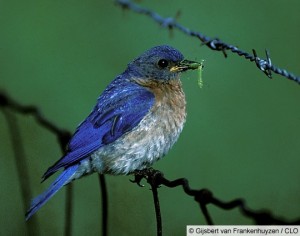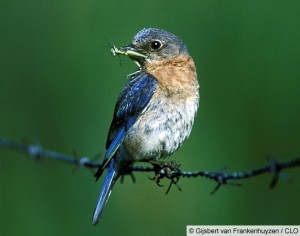Appearance:
The Eastern Bluebird, scientifically known as Sialia sialis, gets its name from its blue appearance. The male has bright blue upper parts, a red/orange throat, breast and flanks, a white lower belly and undertail-coverts, a red/orange or white chin, and a white border on outer retraces (Gowaty and Pissner, 1998).
The female has duller blue/grey upper parts, brown/grey wash across back, blue/grey wash on wings and tail, pale orange underparts, and a white border on outermost retrices (Gowaty and Pissner, 1998).
(Frankenhuyzen, G.)
Both male and female have a stout black bill with a yellow gape and black irises. (Gowaty and Pissner, 1998)
Social Behavior:
The Eastern Bluebird can often be found perching on things such as telephone poles or tree branches. Flight is irregular for these birds, but when flying short distance they usually stay close to the ground at a height of about 10-12m (Gowaty and Pissner, 1998). When they occasionally fly longer distances, they tend to place themselves higher in the air. Most of their day (50-77%) is spent resting (Gowaty and Pissner, 1998). Common active activities include billing, bathing, scratching, sunning, and wing stretching. They get around in a side hop while simultaneously turning 90-180 degrees with each hop (Gowaty and Pissner, 1998).
During the mating season males are aggressive towards each other as a way of mate guarding or in defense of territory. The way that they show this is through facing, gaping, and wing flicking. When they are forming pair bonds, the male often chases the female, and when they are building the nests the male often shows aggression towards the female (Gowaty and Pissner, 1998).
Breeding Behavior:
To attract a female, the male perches outside of the nest cavity and makes displays such as wing flapping or tail raising. The pair bonds are formed once the female enters the nest cavity after a male’s display. They are usually socially monogamous, however there have been a few accounts of polygamy recorded. There is a courtship feeding ritual where they female begs for food from the male, similar to the ways that chick beg for food from their parents (Gowaty and Pissner, 1998).
Nest building begins in late February to early March and may continue for three weeks (Gowaty and Pissner, 1998). It is the male’s job to bring the materials required to build the nest, but is mainly the females responsibility to build the nest. They take the grass and twigs, and loosely weave them together to form out general shape of the nest. To make the inside softer, they usually take fine grass or fur to line the inside of the nest (Gowaty and Pissner, 1998).
They have more than one successful brood a year. The value of male care greatly varies depending on the individual, but it is not a requirement for a successful brood. Females stay close to the nest while foraging as a way to guard the nest (Gowaty and Pissner, 1998).
Habitat and Foraging:
They tend to live in areas with open country with surrounding trees, little understory, and sparse ground cover. This includes pastures and agricultural fields. They live in eastern North America and as far south as Nicaragua(Gowaty and Pissner, 1998).
Their diet mostly consists of insects during the breeding season, and from late summer into winter they usually eat small, fleshy fruits(Gowaty and Pissner, 1998). Occasionally they will also eat larger prey items such as lizards or frogs. They usually eat their prey on the spot, but sometimes bring it up to a tree where they bang it against a branch before consuming it. The Eastern Bluebird drinks from ponds, birdbaths and streams, but seems to prefer running water to standing water(Gowaty and Pissner, 1998). They can be found in Dutchess county in the springtime since they migrate south for the winter. Migration periods vary depending on the location of the bird, and is even considered a “partial migrant” since some individuals stay near their breeding sites for winter residency(Gowaty and Pissner, 1998).
Sources
Gowaty, P.A. and Plissner, J.H. 1998. Eastern bluebird (Sialiasialis), The Birds of North America Online (A. Poole, Ed.). Ithaca: Cornell Lab of Ornithology. Retrieved from the Birds of North America Online:http://bna.birds.cornell.edu.libproxy.vassar.edu/bna/species/381
Zickefoose, J., Adult male Eastern Bluebird, spring [online image] Retrieved November 30, 2014 from http://bna.birds.cornell.edu/bna/species/381/articles/introduction
Frankenhuyzen, G., Adult female Eastern Bluebird, spring [online image] Retrieved November 30, 2014 from http://bna.birds.cornell.edu/bna/species/381/articles/characteristics
Corado, R. (1978) Eastern Bluebird nes, Pennsylvania [online image] Retrieved October 4, 2014 from http://bna.birds.cornell.edu/bna/species/381/articles/breeding




is this bird can sing too?